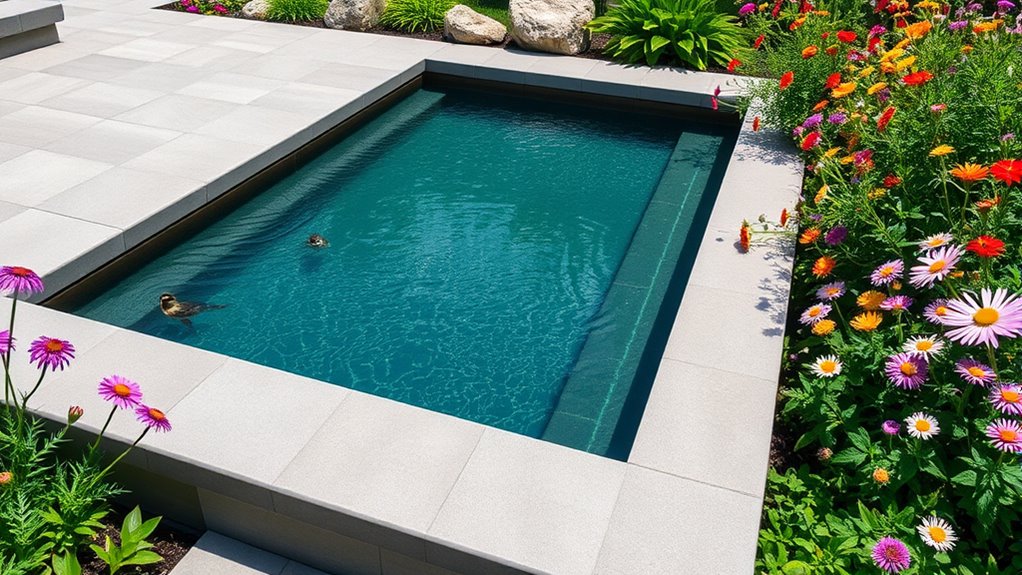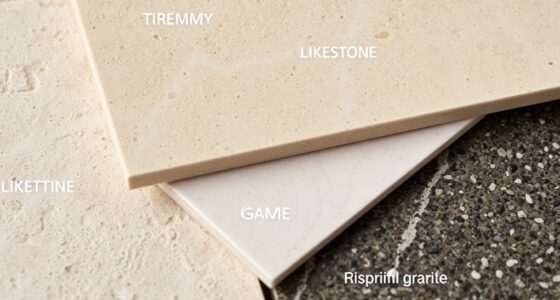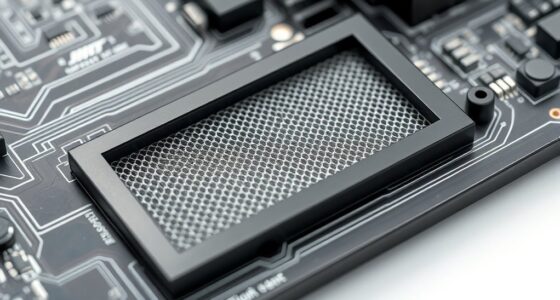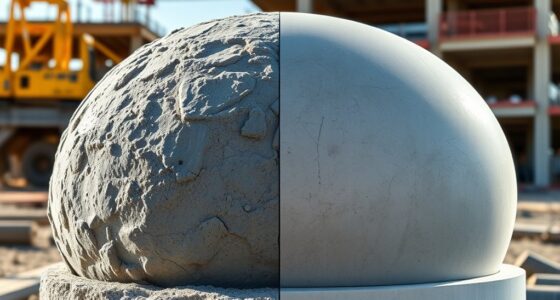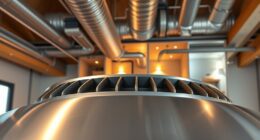To keep runoff out of the basin, guarantee your deck directs water away through proper deck-to-edge drainage design. Use slopes, gutters, and downspouts positioned 3-4 feet from the edges to prevent water pooling. Regularly maintain and clean these components to avoid clogs. Choosing durable materials like aluminum or stainless steel helps improve longevity. For advanced solutions, incorporating sensors or modular systems can enhance efficiency—exploring these options further will help you optimize your drainage setup.
Key Takeaways
- Install gutters with proper slope and width to direct water away from the basin effectively.
- Position downspouts 3-4 feet from deck edges to prevent runoff from spilling into the basin.
- Incorporate overflow outlets and sensors to manage heavy rainfall and monitor runoff flow.
- Regularly clean and maintain gutters and drains to prevent debris buildup and blockages.
- Use durable, eco-friendly materials and proper grading to ensure long-term runoff control and basin protection.
Understanding the Importance of Deck‑to‑Edge Drainage in Basin Design
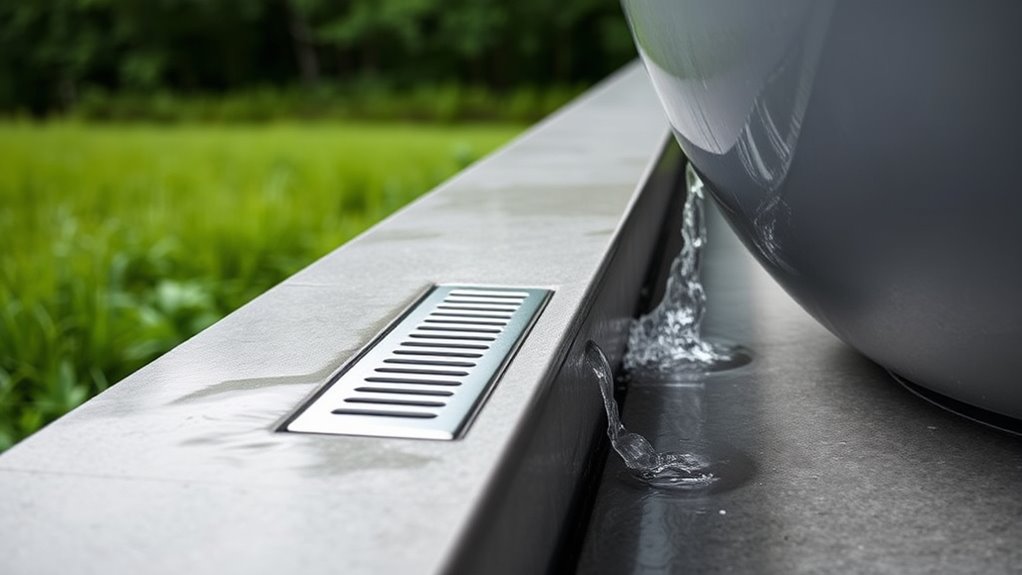
Understanding the importance of deck-to-edge drainage is crucial for effective basin design because proper drainage prevents water from accumulating on the deck surface and spilling over the edges. When water pools on your deck, it can cause structural damage, promote mold growth, and create safety hazards. Effective drainage directs runoff away from the deck, reducing the risk of water infiltration into supporting structures. By ensuring water flows smoothly to designated outlets, you protect the integrity of the entire basin system. Properly managing water runoff also helps maintain the deck’s appearance and prolongs its lifespan. Without adequate drainage, water buildup can lead to costly repairs and safety concerns. Additionally, incorporating proper grading techniques ensures water flows naturally toward drainage points, enhancing overall effectiveness. Prioritizing deck-to-edge drainage in your design is essential for a durable, safe, and well-functioning basin.
Key Components of Effective Deck‑to‑Edge Drainage Systems
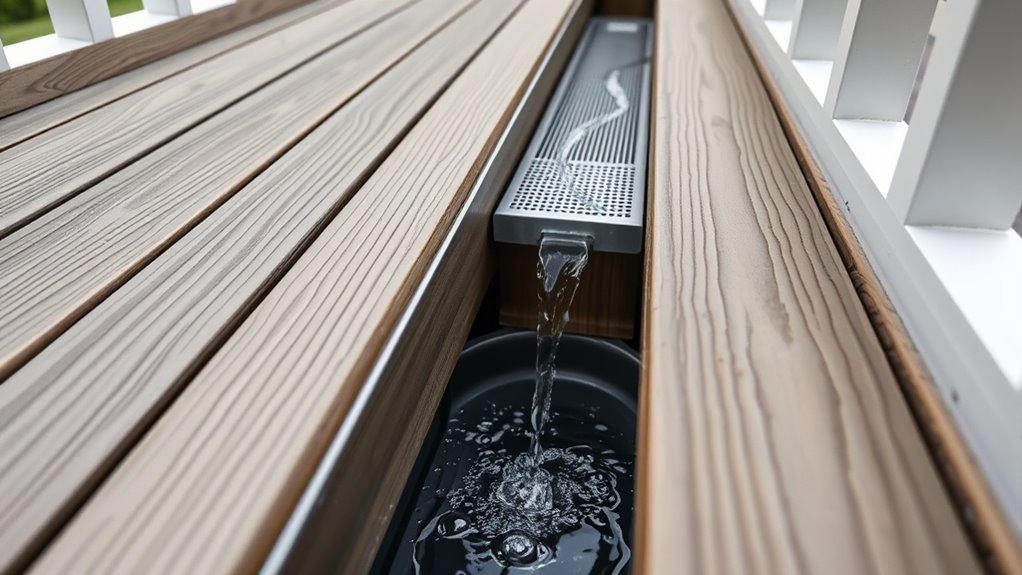
A well-designed deck-to-edge drainage system depends on key components like proper drainage slope and effective gutter design. These elements make certain water flows away efficiently, preventing pooling and damage. Focusing on these details helps you create a reliable and durable drainage setup. Additionally, incorporating proper lighting can enhance visibility and safety around the drainage system, especially in low-light conditions.
Proper Drainage Slope
To guarantee effective deck-to-edge drainage, you need to establish a proper slope that directs water away from the deck surface and foundation. The ideal slope is typically at least 1/4 inch per foot, ensuring water quickly moves off the deck. A slope that’s too shallow can cause water to pool, increasing the risk of leaks and structural damage. Conversely, a slope that’s too steep might cause runoff to flow too rapidly, leading to erosion or splashing onto nearby areas. When constructing or repairing your deck, verify the slope regularly with a level or a string line to maintain proper drainage. Proper slope not only helps keep water out of the basin but also extends the lifespan of your deck by preventing standing water and related issues. Recognizing angel numbers related to love and transformation can remind you to be attentive to signs and signals during your project.
Effective Gutter Design
Have you considered how the design of your gutters can make or break your deck’s drainage? Effective gutter design ensures water flows smoothly away from your deck, preventing pooling and damage. Start with gutters wide enough to handle heavy rain; narrow gutters can overflow easily. Guarantee they have a slight slope—about ¼ inch per 10 feet—to direct water efficiently toward downspouts. Use seamless gutters to minimize leaks and joints that can clog or leak over time. Properly positioned downspouts are essential; they should direct water at least 3 to 4 feet away from the deck’s edge. Additionally, install gutter guards to prevent debris buildup, which can block water flow. Regular maintenance can further enhance gutter performance and longevity. When designed correctly, your gutters will protect your deck from water damage and maintain its integrity.
Common Challenges and How to Overcome Them
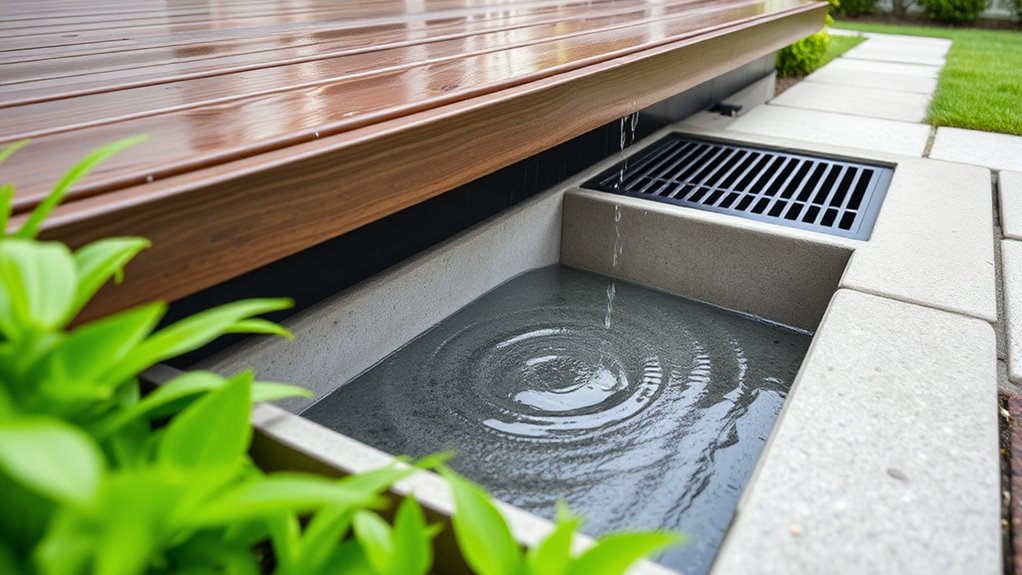
Despite careful planning, deck-to-edge drainage systems often face common challenges that can compromise their effectiveness. One major issue is clogged or blocked drains caused by debris, leaves, or dirt buildup, which can lead to water pooling and potential damage. Another challenge is improper slope or grading, preventing water from flowing efficiently off the deck. Additionally, leaks or poor sealant application at joints can allow water infiltration, risking structural damage. To overcome these issues, regularly inspect and clean drainage components, ensuring they remain unobstructed. Confirm that the deck slope directs water toward the drains. Use high-quality sealants and proper installation techniques to prevent leaks. Regularly monitoring drainage system performance and addressing problems promptly helps maintain effective runoff management and extends the lifespan of your deck’s drainage system.
Material Selection for Durability and Performance
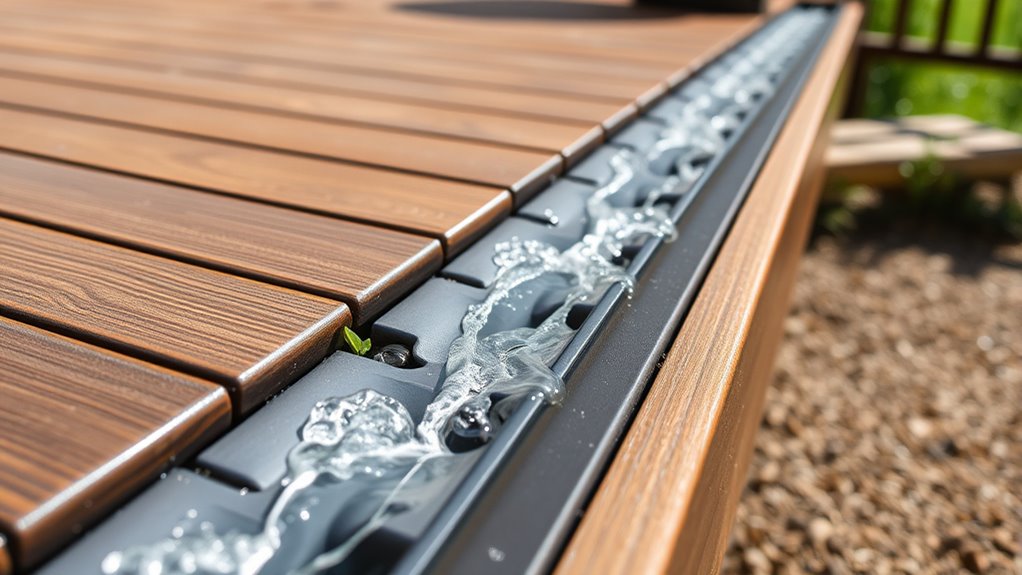
Choosing the right materials for your deck-to-edge drainage system directly impacts its durability and performance over time. Opt for corrosion-resistant metals like aluminum or stainless steel, which withstand weathering and prevent leaks. High-quality, flexible membrane liners ensure water flows smoothly without tearing. Gravel or crushed stone can serve as effective drainage media, preventing soil clogging. Consider the following options:
| Material | Durability | Ideal Use |
|---|---|---|
| Aluminum | Corrosion-resistant | Edges and flashing |
| Geotextile Fabric | Prevents soil clogging | Underlying drainage layers |
| Crushed Stone | Long-lasting, permeable | Base layer for effective runoff |
Selecting these materials guarantees longevity and efficient water management, protecting your structure from water damage. Proper material selection ensures your drainage system performs reliably over time.
Design Principles for Optimal Water Flow Management
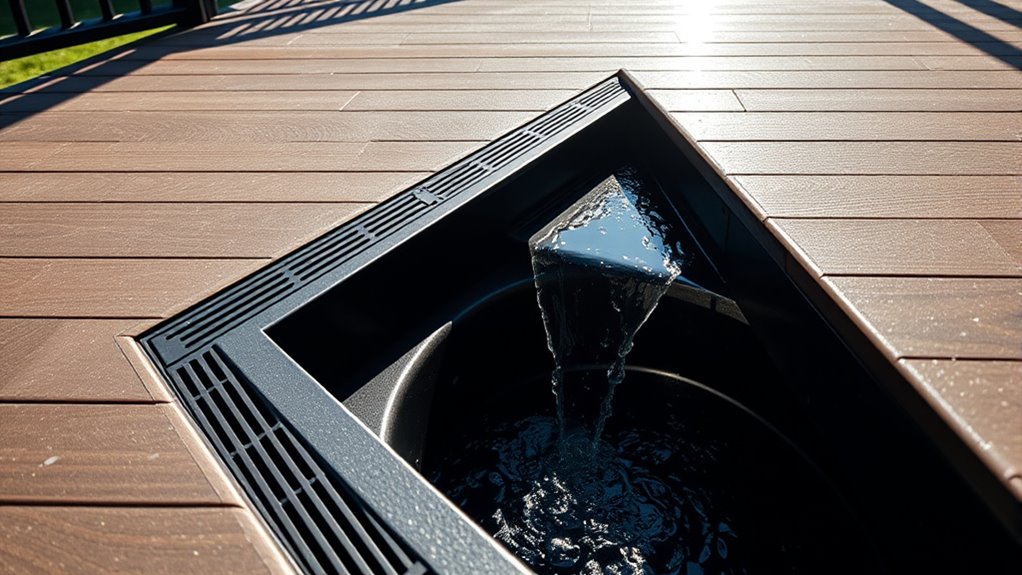
Effective water flow management begins with a well-designed drainage system that directs water away from your structure efficiently. You should guarantee slopes are gentle yet sufficient to guide water toward drainage points without pooling. Position drains, gutters, and downspouts strategically to capture runoff before it reaches vulnerable areas. Keep pathways clear of obstructions to prevent water buildup. Use a consistent flow path that minimizes sharp turns, which can cause turbulence and erosion. Incorporate overflow outlets to handle heavy rainfall without flooding. Maintain proper elevation differences to facilitate gravity-driven flow. Regularly inspect and clean drainage components to prevent clogs. Incorporating AI analytics can help predict heavy rainfall events and optimize your drainage system accordingly. By following these principles, you’ll ensure water moves smoothly away from your deck and foundation, reducing the risk of damage and enhancing overall stability.
Integration of Innovative Technologies and Solutions
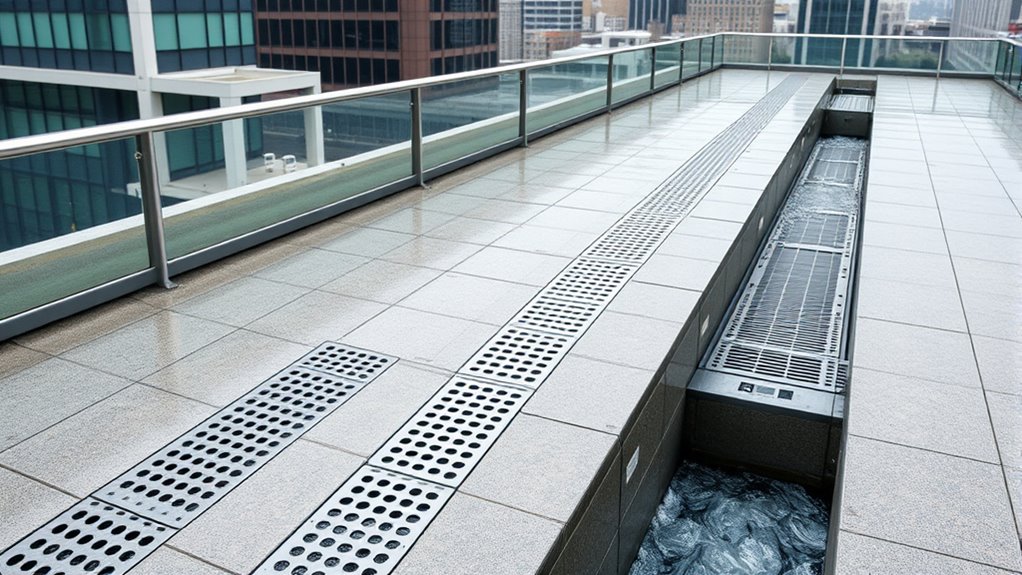
You can improve deck-to-edge drainage by incorporating smart sensors that monitor water flow in real time. Modular systems offer flexibility for easy upgrades and maintenance, while eco-friendly materials help minimize environmental impact. Embracing these innovative solutions ensures more efficient and sustainable drainage management. Additionally, integrating comfort solutions like pressure-relief features can enhance the overall durability and performance of the drainage system.
Smart Drainage Sensors
Integrating smart drainage sensors into deck‑to‑edge drainage systems revolutionizes how you monitor and maintain these structures. These sensors provide real-time data on water levels, flow rates, and potential blockages, enabling proactive management. By detecting issues early, you reduce maintenance costs and prevent overflow or damage. Imagine a system where alerts notify you instantly of drainage inefficiencies, so you can act swiftly. Here’s a simple overview:
| Sensor Type | Function | Benefits |
|---|---|---|
| Water Level Sensor | Measures water height | Prevents overflow |
| Flow Rate Sensor | Tracks runoff speed | Identifies blockages |
| Pressure Sensor | Detects pressure changes | Ensures structural integrity |
Smart sensors empower you to keep runoff out of basins efficiently and reliably. Additionally, understanding relationships can help in designing more resilient drainage systems that adapt to varying environmental conditions.
Modular Drainage Systems
Modular drainage systems leverage innovative technologies to offer flexible, scalable solutions for managing water runoff. These systems are designed for quick installation and easy adjustments, making them ideal for various site conditions. You can customize your setup by:
- Selecting different module sizes to fit specific areas or flow volumes.
- Connecting multiple modules to expand capacity as needed.
- Incorporating sensors or drainage outlets for real-time monitoring and control.
- Emphasize the importance of adaptability in maintaining effective water management over time.
This modular approach ensures efficient water management while reducing installation time and costs. Plus, you can adapt and expand the system over time, avoiding the need for complete redesigns. By integrating these advanced solutions, you keep runoff out of the basin, protecting your structure and the surrounding environment effectively.
Eco-Friendly Materials
Using eco-friendly materials in drainage systems not only helps reduce environmental impact but also enhances sustainability and long-term durability. You can choose options like recycled plastics, permeable pavements, or biodegradable geotextiles that minimize waste and promote natural water flow. These materials prevent pollution, lower carbon footprints, and often require less maintenance. To help you compare options, here’s a quick overview:
| Material | Benefits |
|---|---|
| Recycled Plastics | Durable, reduces plastic waste |
| Permeable Pavements | Allows water infiltration, reduces runoff |
| Biodegradable Geotextiles | Eco-friendly, supports plant growth |
| Cork and Hemp | Sustainable, natural alternatives |
Best Practices for Maintenance and Inspection
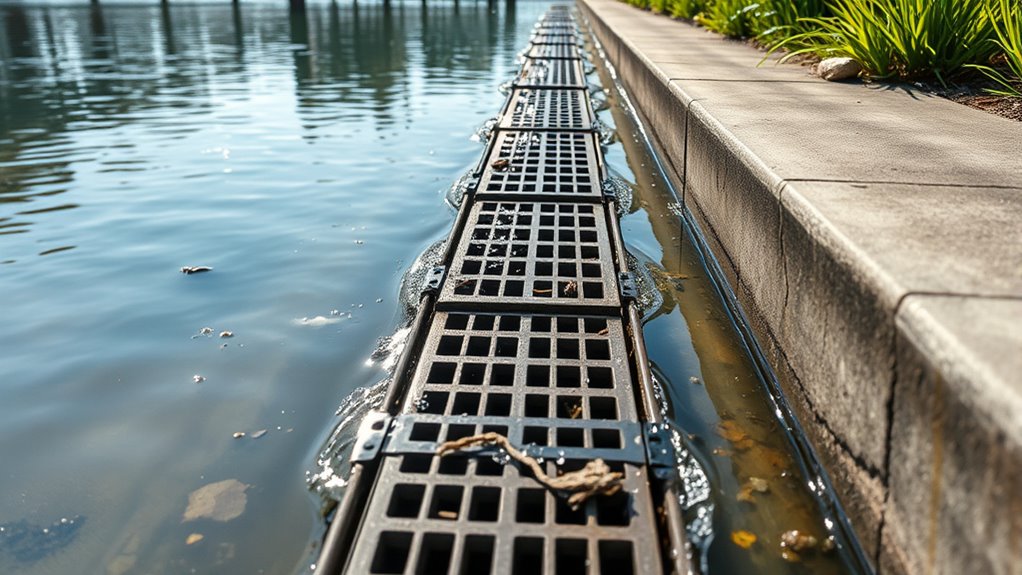
Regular maintenance and thorough inspections are essential to ensuring the longevity and effectiveness of deck-to-edge drainage systems. To keep everything functioning smoothly, follow these best practices:
- Check for blockages in gutters and drainage channels regularly, especially after storms or heavy rain.
- Clear debris like leaves, dirt, and twigs that can clog the system and impede water flow.
- Inspect for cracks, leaks, or damage to drainage components, repairing issues immediately to prevent further deterioration.
Case Studies Showcasing Successful Implementations
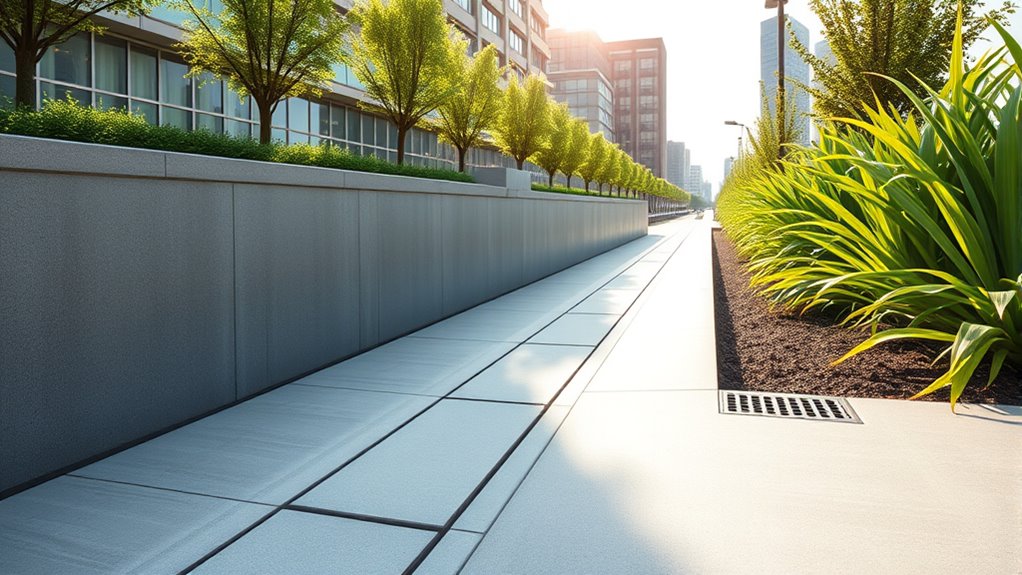
Examining real-world examples highlights how effective deck-to-edge drainage systems can be when properly maintained. In one project, a commercial building incorporated a well-designed drainage system that redirected rainwater efficiently, preventing pooling and basement flooding. Regular inspections and timely repairs kept the system functioning ideally, demonstrating the importance of upkeep. Another case involved a residential complex that integrated seamless edge drains, reducing debris buildup and ensuring consistent runoff removal. These implementations show that investing in quality materials and thoughtful design pays off by minimizing water intrusion into basins. Overall, these successful case studies prove that with proper planning, installation, and maintenance, deck-to-edge drainage systems can greatly improve water management and protect structures from water damage.
Future Trends in Stormwater Management and Drainage Design
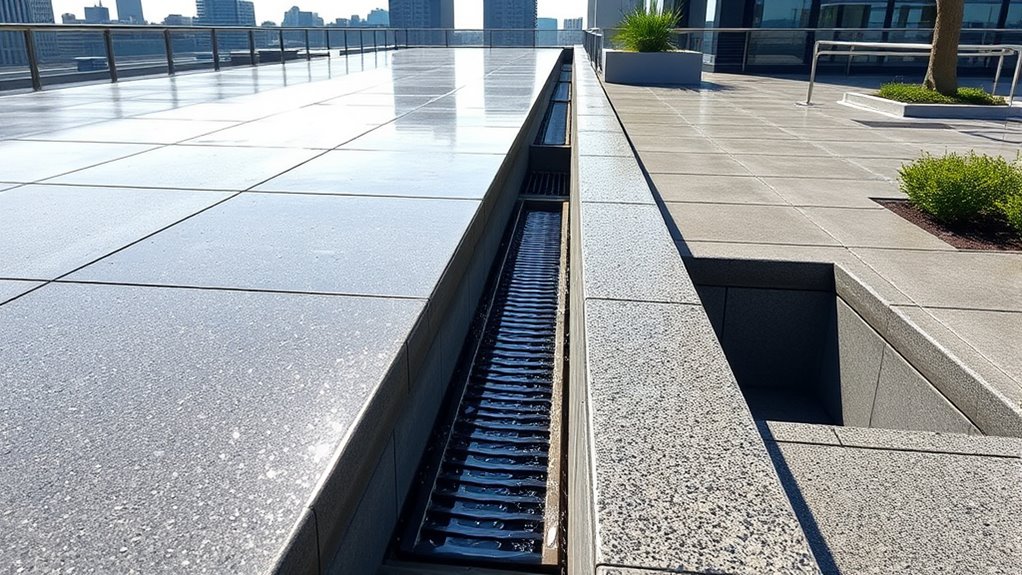
As technology advances, stormwater management and drainage design are increasingly shifting toward smarter, more sustainable solutions. You’ll see innovations that prioritize efficiency and environmental health. Here are three future trends to watch:
- Green infrastructure, like rain gardens and permeable pavements, will become standard, reducing runoff and promoting groundwater recharge.
- IoT sensors and real-time data analytics will optimize drainage systems, allowing quick responses to heavy rainfall and preventing flooding.
- Modular, adaptable designs will enable easier upgrades and maintenance, ensuring systems stay effective as urban landscapes evolve.
These advancements will help you create resilient, eco-friendly drainage solutions that protect communities and natural resources for years to come.
Frequently Asked Questions
How Does Climate Change Impact Deck‑To‑Edge Drainage Effectiveness?
Climate change can diminish deck-to-edge drainage effectiveness by causing more intense and unpredictable rainfall, which overwhelms existing drainage systems. You might notice water pooling or overflowing more frequently, risking damage or leaks. To stay ahead, you should regularly inspect and maintain your drainage system, ensure proper slope, and upgrade components if needed. Adapting your drainage setup helps prevent water buildup and protects your structure against increasingly severe weather.
What Are the Cost Considerations for Installing Advanced Drainage Systems?
You’ll find that advanced drainage systems cost more upfront, but they save you money in the long run by preventing costly water damage. Sure, the installation might make your budget groan, and maintenance can seem like an extra expense, but ignoring them could lead to even pricier repairs later. Investing in smarter drainage now means fewer surprises and peace of mind, proving that sometimes, spending more saves you more.
Can Deck‑To‑Edge Drainage Be Integrated With Existing Basin Infrastructure?
Yes, you can integrate deck-to-edge drainage with existing basin infrastructure. You’ll need to evaluate the current system’s capacity and design compatibility, often involving modifications or upgrades. Collaborate with engineers to ensure seamless flow and prevent overflow. Proper planning minimizes disruptions and ensures the new drainage system works effectively alongside existing features, helping you maintain proper runoff control and protect your basin from potential erosion or flooding.
How Do Local Regulations Influence Drainage System Design Choices?
Think of local regulations as the blueprint guiding your drainage system design. They set the rules you must follow, shaping choices on materials, slope, and capacity, ensuring safety and compliance. Ignoring them is like sailing without a map—you risk penalties or system failure. By understanding and integrating these regulations early, you steer your project smoothly, balancing functionality with legal requirements, ultimately creating an effective, compliant drainage system that stands the test of time.
What Training Is Recommended for Maintenance Personnel?
You should undergo specialized training in drainage system maintenance, including understanding water flow dynamics and identifying potential blockages or damage. Focus on courses that cover inspecting drainage components, cleaning protocols, and safety procedures. Hands-on workshops are especially valuable to build practical skills. Staying updated with manufacturer guidelines and local regulations guarantees you perform maintenance effectively, preventing runoff from entering basins and maintaining proper drainage function.
Conclusion
By prioritizing deck-to-edge drainage, you’re like a skilled conductor directing water away from your basin, ensuring smooth flow and avoiding costly damage. When you choose the right materials, follow proven design principles, and stay vigilant with maintenance, you’ll keep runoff out of the basin as effectively as a dam holds back a rushing river. Embrace innovative solutions and future trends to stay ahead—your basin’s health depends on it.
